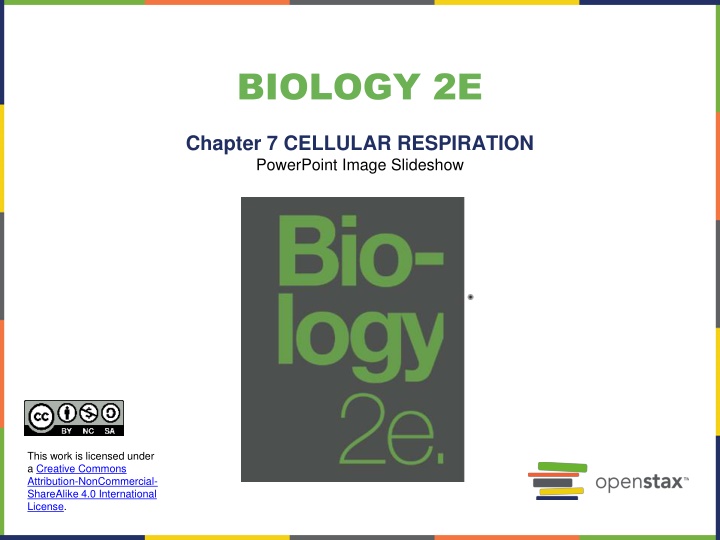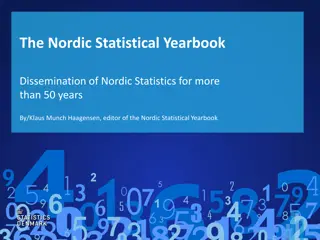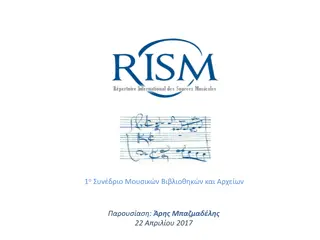
Cellular Respiration Overview and Energy Transfer in Living Systems
Explore the process of cellular respiration and the transfer of energy through redox reactions and electron carriers in living systems. Understand the role of molecules like NAD and ATP in generating ATP for cellular energy production.
Download Presentation

Please find below an Image/Link to download the presentation.
The content on the website is provided AS IS for your information and personal use only. It may not be sold, licensed, or shared on other websites without obtaining consent from the author. If you encounter any issues during the download, it is possible that the publisher has removed the file from their server.
You are allowed to download the files provided on this website for personal or commercial use, subject to the condition that they are used lawfully. All files are the property of their respective owners.
The content on the website is provided AS IS for your information and personal use only. It may not be sold, licensed, or shared on other websites without obtaining consent from the author.
E N D
Presentation Transcript
BIOLOGY 2E Chapter 7 CELLULAR RESPIRATION PowerPoint Image Slideshow This work is licensed under a Creative Commons Attribution-NonCommercial- ShareAlike 4.0 International License.
OVERVIEW: CELLULAR RESPIRATION Cells extract energy from food to generate ATP in a process called glucose catabolism or cellular respiration. As we work through the metabolic pathways involved, notice the close link between the transfer of energy and the movement of electrons (electrons have high energy levels). This incremental transfer of electrons allows the cell to transfer food energy in small packages that can be captured in the phosphate bonds of ATP.
7.1 ENERGY IN LIVING SYSTEMS ELECTRONS AND ENERGY Oxidation reductions (redox) reactions are chemical reactions where electrons are transferred from one molecule to another. Molecules that can donate electron(s) in a redox reaction are reducing agents, and those that can accept electrons are oxidizing agents. Molecules that gain electron(s) after the reaction are reduced, and those that lose electron(s) are oxidized. AH (Reducing Agent) (Oxidizing agent) + A+ X+ XH (reduced) + ? (oxidized)
7.1 ENERGY IN LIVING SYSTEMS ELECTRON CARRIERS Molecules like nicotineamide adenine dinucleotide (NAD) can occur in an oxidized state (NAD+) or a reduced state (NADH). NADH carries 2e- and 1H+ more than NAD NAD is called an electron carrier because NAD+ accepts electrons from redox reactions while NADH donates them. Electron carriers are very important molecules in cellular respiration and photosynthesis. They shuttle electrons to electron transport chains where ATP is produced. Other electron carriers include: FAD+, (oxidized)/ FADH2 (reduced) NADP+(oxidized)/ NADPH (reduced)
7.1 ENERGY IN LIVING SYSTEMS ELECTRON CARRIERS NAD+ (oxidized)/ NADH (reduced)
7.1 ENERGY IN LIVING SYSTEMS - ATP The hydrolysis of ATP ? exergonic and can provide energy for a coupled endergonic reaction. ADP + Pi is The loss of a phosphate group from a molecule is called dephosphorylation. Phosphorylation is the process of adding a phosphate group is to a molecule. Phosphorylated molecules tend to be less stable and more likely to react.
7.1 ENERGY IN LIVING SYSTEMS - ATP Adenosine triphosphate (ATP)
7.1 ENERGY IN LIVING SYSTEMS - ATP ATP is generated by an endergonic reaction where ADP undergoes phosphorylation, ADP + Pi ? ATP. The energy required for this reaction can come from: 1. Substrate-level phosphorylation - a coupled exergonic reaction 2. Chemiosmosis- a process which uses energy from a concentration gradient and requires the enzyme ATP synthase. 90% of ATP is produced by chemiosmosis. Occurs in mitochondria, chloroplasts, and plasma membrane of aerobic prokaryotes.
7.1 ENERGY IN LIVING SYSTEMS - ATP Mitochondrion Structure
OVERVIEW: CELLULAR RESPIRATION C6H12O6+ 6 O2? 6 CO2+ 6 H2O + ~36 ATP The metabolic pathways involved are: Glycolysis Oxidation of Pyruvate and Citric Acid Cycle Oxidative Phosphorylation
7.2 GLYCOLYSIS Glycolysis is the first metabolic pathway of cellular respiration and includes 10 enzymatic reactions. Nearly all organisms perform glycolysis occurs in the cytoplasm O2is not required Inputs: 1 Glucose, 2 NAD+, 2 ATP, 4 ADP Outputs: 2 Pyruvate, 2 NADH, 4 ATP, 2 ADP ? ? ? ? ? ? ? ? ? ? - - 10 reactions + Glucose Pyruvate
7.2 GLYCOLYSIS ENERGY-REQUIRING STEPS The first half of glycolysis involves 5 enzymes and uses two ATP molecules. Glucose is phosphorylated twice and then split into two three-carbon molecules, called glyceraldehyde-3- phosphate (G3P).
7.2 GLYCOLYSIS ENERGY-RELEASING STEPS The second half of glycolysis involves phosphorylation without ATP investment (step 6) and produces two NADH and four ATP molecules to generate 2 pyruvate molecules. Net ATP production of glycolysis is 2 ATP. These are the only ATP produced in glucose catabolism by anaerobic cells.
7.2 GLYCOLYSIS https://www.youtube.com/watch?v=8Kn6BVGqKd8
7.3 OXIDATION OF PYRUVATE In eukaryotic cells, if oxygen is present, the 2 pyruvate molecules enter mitochondria where each is converted to Acetyl CoA before entering the CAC: 1. CO2 is released 2. It is oxidized, transferring e- to NADH 3. coenzyme A is attached Inputs: 2 pyruvate, 2 NAD+ 2 coenzyme A Outputs: 2 CO2, 2 NADH, 2 acetyl CoA
7.3 CITRIC ACID CYCLE Occurs in the mitochondrial matrix. Step 1 - the acetyl group from acetyl CoA is transferred to oxaloacetate to form citrate. Through a cycle of reactions citrate is oxidized (3 NADH & 1 FADH2made) 2 CO2released 1 GTP or ATP produced The final product of the citric acid cycle is oxaloacetate.
OVERVIEW: CELLULAR RESPIRATION Outputs: Glycolysis, Pyruvate Oxidation and the Citric Acid Cycle 4 ATP (2 from glycolysis, 2 from CAC) 6 CO2 (2 from oxidation of pyruvate, 4 from CAC) 10 NADH (2 from glycolysis, 2 from oxidation of pyruvate, 6 from CAC) 2 FADH2(from CAC) Glucose is completely oxidized at the end of CAC. All possible electrons have been removed. Question: Is most of the energy from glucose stored in the ATP, the CO2, or the electron carrier molecules?
7.4 OXIDATIVE PHOSPHORYLATION Most of the ATP produced during cellular respiration occurs in the last pathway, oxidative phosphorylation. This is the only pathway where O2is an input. The pathway consists of an electron transport chain and chemiosmosis, which generates ATP. A H+concentration gradient created by the ETC, provides the energy to power chemiosmosis.
7.4 OXIDATIVE PHOSPHORYLATION Mitochondrion Structure
7.4 OXIDATIVE PHOSPHORYLATION- ELECTRON TRANSPORT CHAIN (ETC) https://www.youtube.com/watch? v=xbJ0nbzt5Kw The ETC is a series of electron transporters embedded in the inner mitochondrial membrane. They shuttle electrons from NADH and FADH2to O2. In the process, protons (H+) are pumped from the mitochondrial matrix to the intermembrane space, and O2is reduced to form H2O.
7.4 OXIDATIVE PHOSPHORYLATION- ELECTRON TRANSPORT CHAIN (ETC) Each component of the ETC is more electronegative than the previous. e- from NADH are transferred to complex I of ETC Includes NADH dehydrogenase, a B- vitamin derived molecule, & an Fe-S containing protein
7.4 OXIDATIVE PHOSPHORYLATION- ELECTRON TRANSPORT CHAIN (ETC) e- from FADH2enter the ETC at complex II. Ubiquinone (Q) carries e- from complexes I and II to complex III Complex III is called cytochrome oxidoreductase. Includes transmembrane cytochrome B and peripheral protein cytochrome C Cytochrome C carries each e- to complex IV Oxygen is reduced at complex IV (the final e- acceptor)
7.4 OXIDATIVE PHOSPHORYLATION CHEMIOSMOSIS Chemiosmosis uses kinetic energy from protons falling down its gradient to form ATP from ADP + Pi. The complex, integral protein ATP synthase mediates this reaction. www.youtube.com/watch?v=3y1 dO4nNaKY (Credit: modification of work by Klaus Hoffmeier)
7.4 OXIDATIVE PHOSPHORYLATION ATP Yield The number of ATP generated by cellular respiration is 30-36 per glucose Varies by species and how efficiently NADH from glycolysis enters mitochondria Cellular respiration in total stores ~ 34% of the energy from glucose in ATP
7.5 METABOLISM WITHOUT OXYGEN ANAEROBIC RESPIRATION Prokaryotic cells (Domains Bacteria and Archaea) Use a terminal electron acceptor other than oxygen in the electron transport chain. Figure 7.13 The green color seen in these coastal waters is from an eruption of hydrogen sulfide producing bacteria. These anaerobic, sulfate-reducing bacteria release hydrogen sulfide gas as they decompose algae in the water. (credit: modification of work by NASA/Jeff Schmaltz, MODIS Land Rapid Response Team at NASA GSFC, Visible Earth Catalog of NASA images)
7.5 METABOLISM WITHOUT OXYGEN - FERMENTATION Glycolysis occurs in aerobic and anaerobic environments. NAD+is an input of glycolysis; regenerated during oxidative phosphorylation when O2 is present. When O2is lacking, fermentation regenerates NAD+; otherwise, glycolysis would halt. There are two common types of fermentation Lactic acid fermentation Alcohol fermentation
7.5 METABOLISM WITHOUT OXYGEN - FERMENTATION Lactic Acid Fermentation Occurs in muscle cells when O2is limited, mammalian red blood cells, & some bacteria, ex. those in yogurt Lactate dehydrogenase catalyzes this reaction. Pyruvate + NADH ? ? NAD+ lactate +
7.5 METABOLISM WITHOUT OXYGEN - FERMENTATION Lactic Acid Fermentation
7.5 METABOLISM WITHOUT OXYGEN - FERMENTATION Alcoholic Fermentation anaerobic yeast species Involves two reactions First, catalyzed by pyruvate decarboxylase Second, by alcohol dehydrogenase Fermentation tanks have valves so that the pressure inside the tanks created by the CO2produced can be released. Pyruvate ? acetylaldehide acetylaldehide + NADH? NAD+ CO2+ ethanol +
7.5 METABOLISM WITHOUT OXYGEN - FERMENTATION Measuring Respiration in Yeast https://www.youtube.com/watch?v=Cngt2HmJuSo
7.6 CONNECTIONS OF CARBOHYDRATE, PROTEIN AND LIPID METABOLIC PATHWAYS Catabolic pathways for carbohydrates, lipids, and proteins eventually connect to glycolysis or the CAC pathways.
7.6 CONNECTIONS OF CARBOHYDRATE, PROTEIN AND LIPID METABOLIC PATHWAYS Amino Acids that enter the Citric Acid Cycle do so at different locations, depending on the AA.
7.7 REGULATION OF CELLULAR RESPIRATION Cellular respiration is regulated by many mechanisms, including: - Hormonal control of glucose entry into the cell - Enzyme reversibility (functioning to substrate product equilibrium) or irreversibility (able to exceed equilibrium) - Enzyme sensitivity to pH changes due to lactic acid build- up - Feedback controls
7.7 REGULATION OF CELLULAR RESPIRATION Pathway Enzyme affected Elevated levels of effector Effect on pathway activity glycolysis Hexokinase Glucose-6-phosphate decrease Phosphofructokinase Fructose-6-phosphate increase Citrate, acidic pH decrease Pyruvate to acetyl coA Pyruvate dehydrogenase ADP, pyruvate increase Acetyl coA, ATP, NADH decrease CAC Isocitrate dehydrogenase ADP increase ATP, NADH decrease Ketoglutarate dehydrogenase Calcium ions, ADP increase ATP, NADH, succinyl coA decrease ETC ADP Increase ATP decrease






















